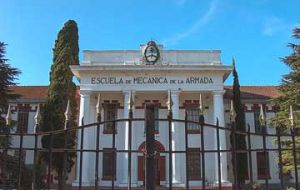MercoPress. South Atlantic News Agency
Argentine torture centre turned into human rights bastion
 ESMA building at Bs. Aires
ESMA building at Bs. Aires The grounds of the largest clandestine detention and torture centre in Buenos Aires during Argentina's “dirty war” crackdown on dissent are now a United Nations human rights centre.
Nearly 5,000 political prisoners are estimated to have passed through the main building of the former Navy Mechanics' School during the 1976-83 dictatorship. After being tortured with racks, electrical prods and other devices, an estimated 90 percent of the prisoners were executed, joining the 13,000 who were killed or made "to disappear." Rights groups put the number closer to 30,000. The site became emblematic of the human rights violations committed by the region's military dictatorships during the 1970s and 1980s. On Friday, Argentine President Cristina Fernandez de Kirchner and the head of UNESCO inaugurated the International Centre for the Promotion of Human Rights on the grounds of the former school. "The centre is a symbol of the contribution of Latin America to the promotion of human rights on a global level," UNESCO Director-General Koichiro Matsuura said, referring to the ongoing trials and investigations of former leaders of the region's military dictatorships. But hosting the centre is a bittersweet honour, said Mrs. Kirchner. "The distinction implies the recognition of ... perhaps the greatest tragedy our country has ever lived and whose consequences our society is still suffering" she said. The centre will receive reports of human rights abuses and host seminars in the nearly three dozens buildings on the 17 hectare grounds, but not in the detention centre itself, which was declared a national monument. Fifty-six former state security agents and their civilian allies have been charged and are being held for alleged crimes against humanity that took place in the centre, known as the ESMA, according to the Centre for Legal and Social Studies in Buenos Aires. Also Friday, Mrs. Kirchner announced that DNA tests had established the true identity of a 32-year-old woman taken from her parents during the dictatorship — the 97th such child identified by the Grandmothers of the Plaza de Mayo human rights group. Human rights groups say hundreds of children were taken from political prisoners and given to military or politically connected families at the time.




Top Comments
Disclaimer & comment rulesCommenting for this story is now closed.
If you have a Facebook account, become a fan and comment on our Facebook Page!